University Name - International Business: Central Bank Report Analysis
VerifiedAdded on 2022/09/11
|15
|3798
|9
Report
AI Summary
This report provides a comprehensive overview of the role and significance of central banks in the global economy, with a specific focus on the European Central Bank (ECB). It examines the key functions of central banks, including managing monetary policy, controlling the money supply, setting interest rates, and maintaining price stability. The report delves into the importance of central banks in achieving economic growth and financial stability, discussing various monetary policies and their impact on inflation, employment, and exchange rates. Furthermore, it analyzes the structure and operations of the ECB, highlighting its role in the Eurozone and its influence on the economic and monetary integration of the European Union. The report also explores the relationship between central banks and political power, and discusses the challenges and opportunities faced by central banks in the modern global economy.
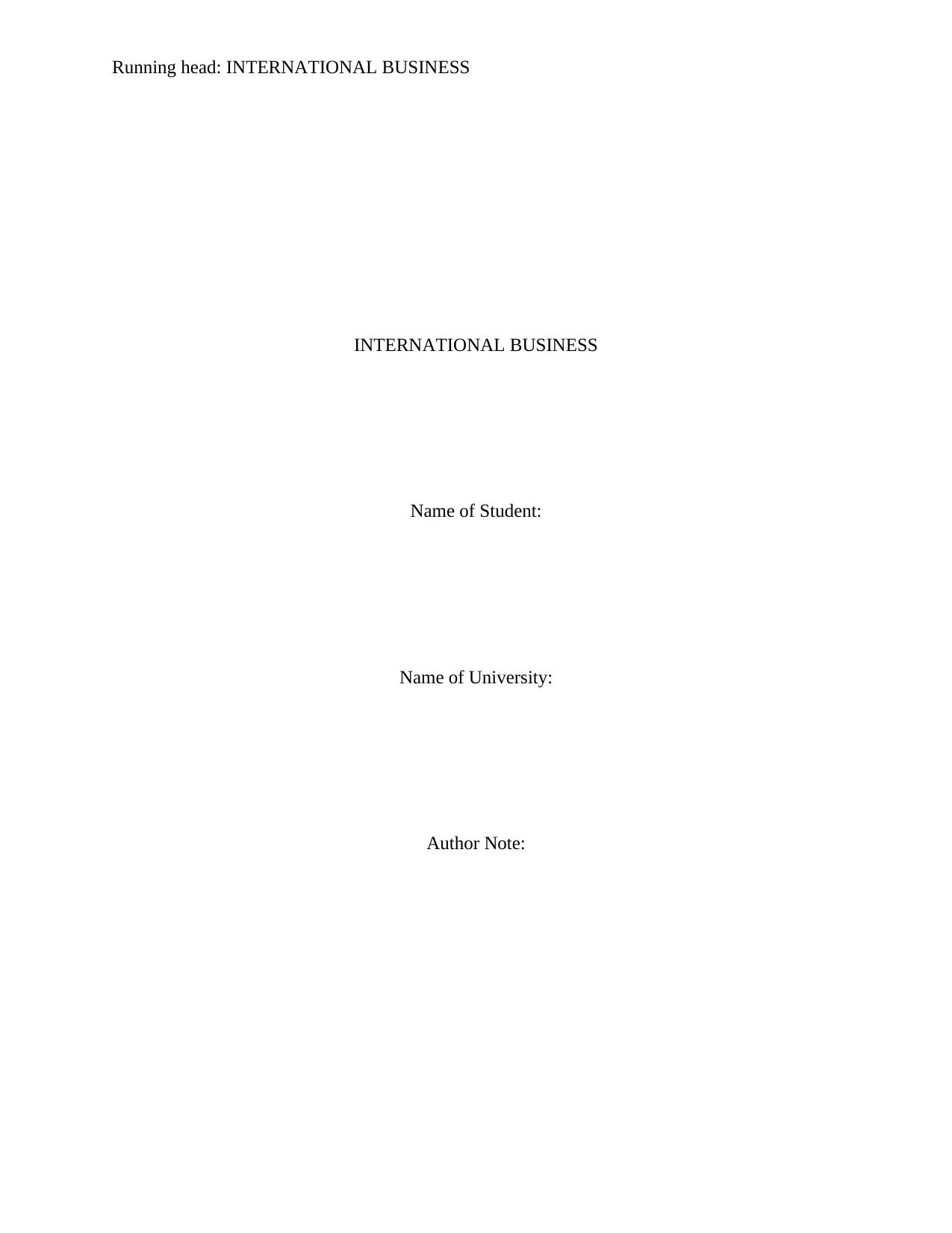
Running head: INTERNATIONAL BUSINESS
INTERNATIONAL BUSINESS
Name of Student:
Name of University:
Author Note:
INTERNATIONAL BUSINESS
Name of Student:
Name of University:
Author Note:
Paraphrase This Document
Need a fresh take? Get an instant paraphrase of this document with our AI Paraphraser
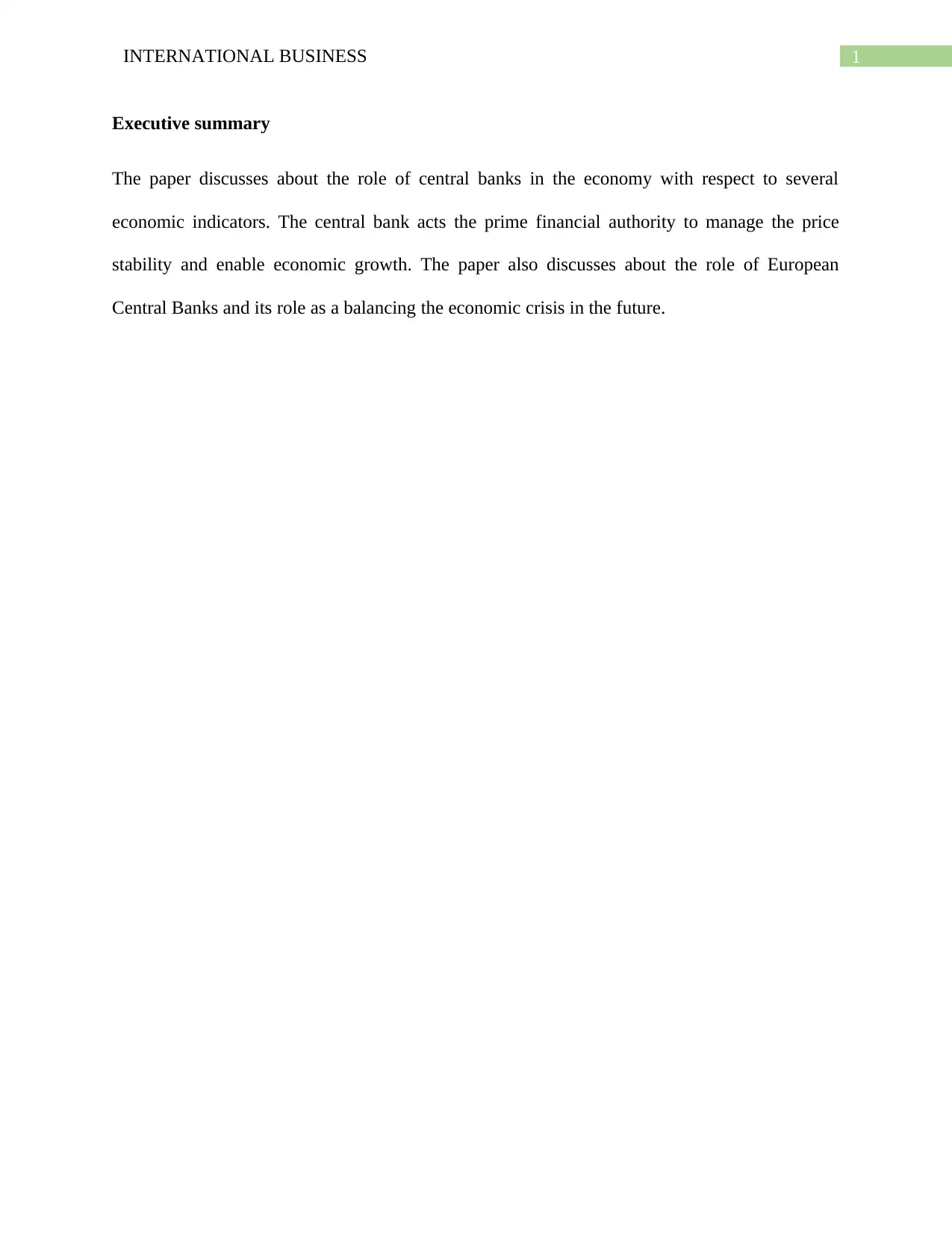
1INTERNATIONAL BUSINESS
Executive summary
The paper discusses about the role of central banks in the economy with respect to several
economic indicators. The central bank acts the prime financial authority to manage the price
stability and enable economic growth. The paper also discusses about the role of European
Central Banks and its role as a balancing the economic crisis in the future.
Executive summary
The paper discusses about the role of central banks in the economy with respect to several
economic indicators. The central bank acts the prime financial authority to manage the price
stability and enable economic growth. The paper also discusses about the role of European
Central Banks and its role as a balancing the economic crisis in the future.
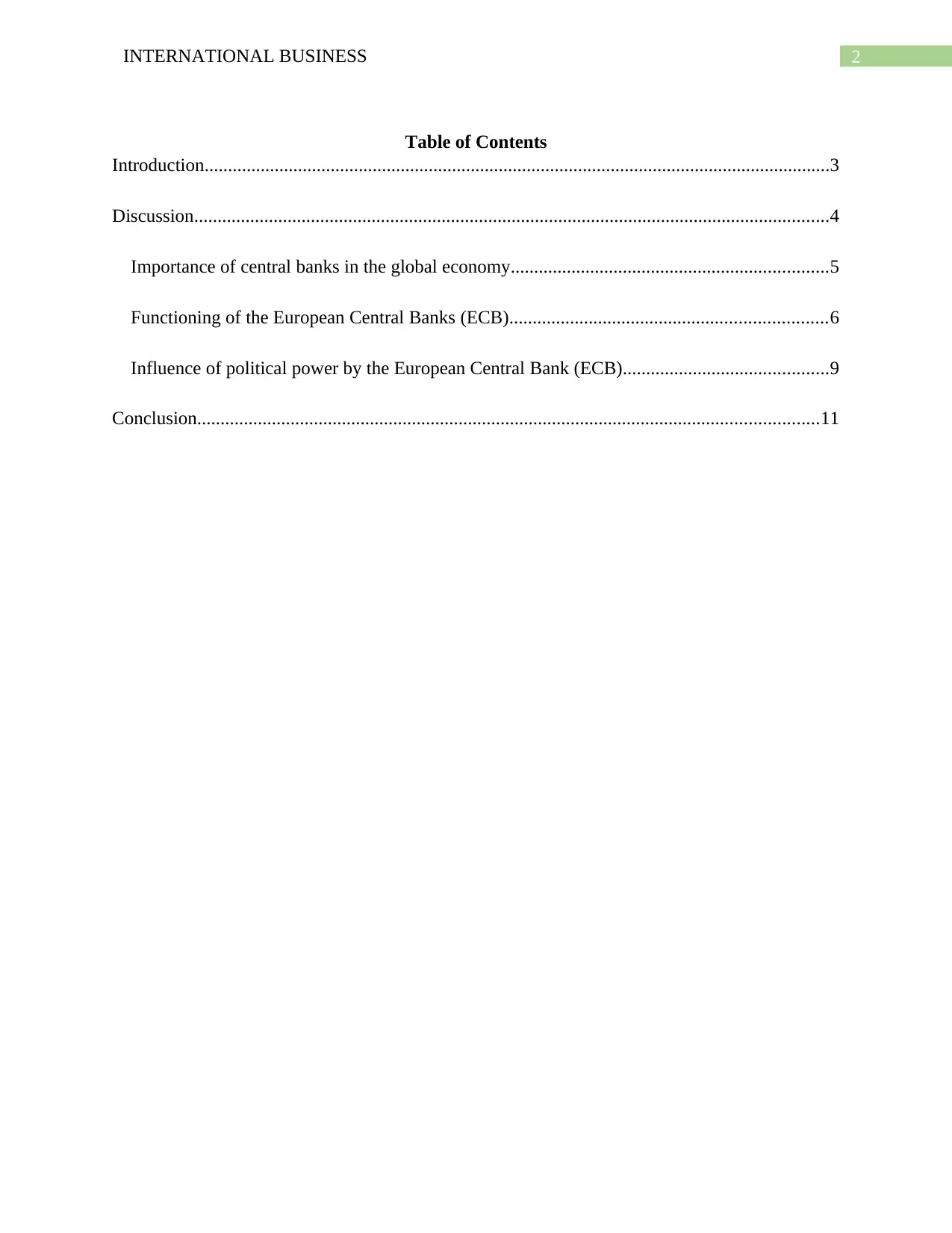
2INTERNATIONAL BUSINESS
Table of Contents
Introduction......................................................................................................................................3
Discussion........................................................................................................................................4
Importance of central banks in the global economy....................................................................5
Functioning of the European Central Banks (ECB)....................................................................6
Influence of political power by the European Central Bank (ECB)............................................9
Conclusion.....................................................................................................................................11
Table of Contents
Introduction......................................................................................................................................3
Discussion........................................................................................................................................4
Importance of central banks in the global economy....................................................................5
Functioning of the European Central Banks (ECB)....................................................................6
Influence of political power by the European Central Bank (ECB)............................................9
Conclusion.....................................................................................................................................11
⊘ This is a preview!⊘
Do you want full access?
Subscribe today to unlock all pages.

Trusted by 1+ million students worldwide
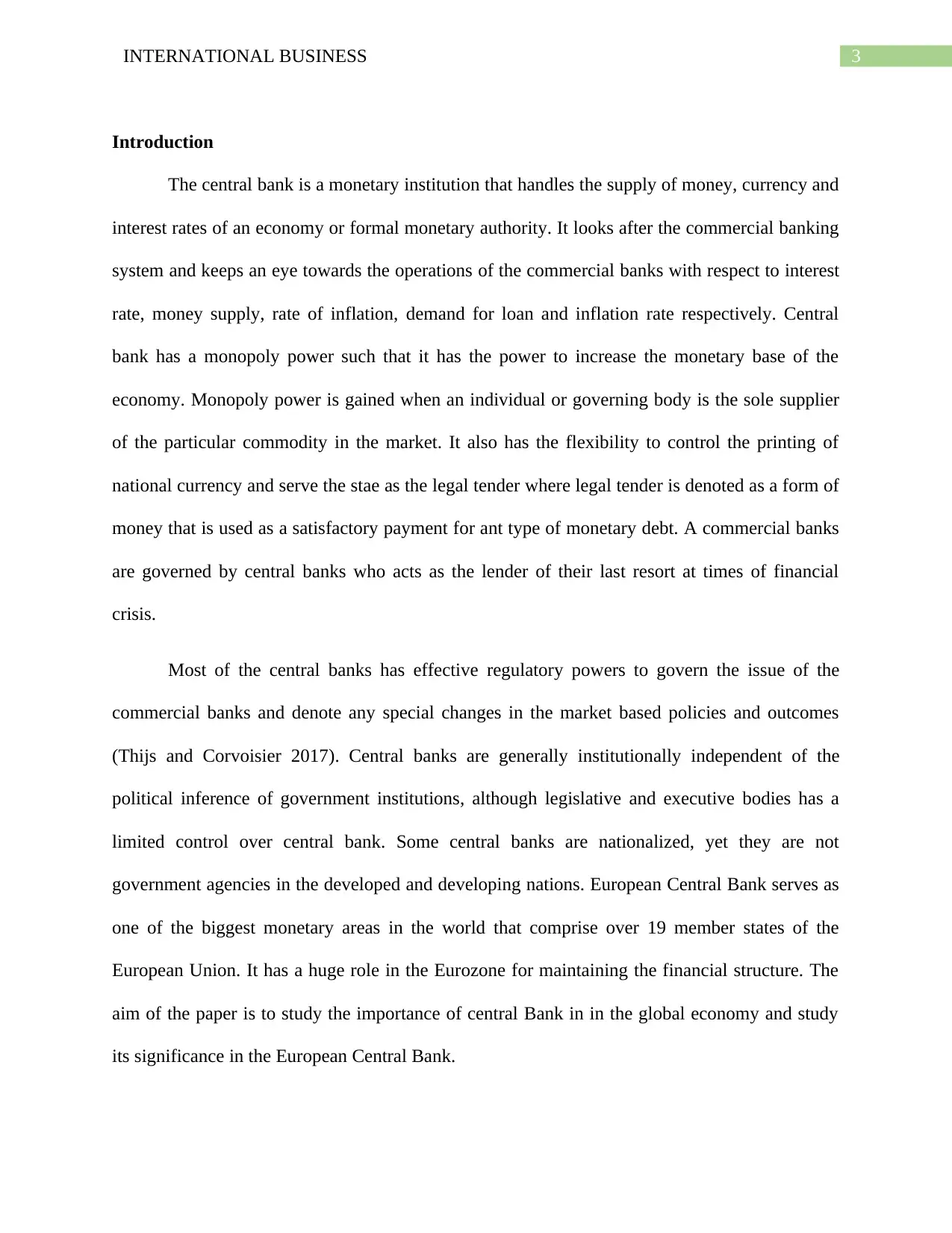
3INTERNATIONAL BUSINESS
Introduction
The central bank is a monetary institution that handles the supply of money, currency and
interest rates of an economy or formal monetary authority. It looks after the commercial banking
system and keeps an eye towards the operations of the commercial banks with respect to interest
rate, money supply, rate of inflation, demand for loan and inflation rate respectively. Central
bank has a monopoly power such that it has the power to increase the monetary base of the
economy. Monopoly power is gained when an individual or governing body is the sole supplier
of the particular commodity in the market. It also has the flexibility to control the printing of
national currency and serve the stae as the legal tender where legal tender is denoted as a form of
money that is used as a satisfactory payment for ant type of monetary debt. A commercial banks
are governed by central banks who acts as the lender of their last resort at times of financial
crisis.
Most of the central banks has effective regulatory powers to govern the issue of the
commercial banks and denote any special changes in the market based policies and outcomes
(Thijs and Corvoisier 2017). Central banks are generally institutionally independent of the
political inference of government institutions, although legislative and executive bodies has a
limited control over central bank. Some central banks are nationalized, yet they are not
government agencies in the developed and developing nations. European Central Bank serves as
one of the biggest monetary areas in the world that comprise over 19 member states of the
European Union. It has a huge role in the Eurozone for maintaining the financial structure. The
aim of the paper is to study the importance of central Bank in in the global economy and study
its significance in the European Central Bank.
Introduction
The central bank is a monetary institution that handles the supply of money, currency and
interest rates of an economy or formal monetary authority. It looks after the commercial banking
system and keeps an eye towards the operations of the commercial banks with respect to interest
rate, money supply, rate of inflation, demand for loan and inflation rate respectively. Central
bank has a monopoly power such that it has the power to increase the monetary base of the
economy. Monopoly power is gained when an individual or governing body is the sole supplier
of the particular commodity in the market. It also has the flexibility to control the printing of
national currency and serve the stae as the legal tender where legal tender is denoted as a form of
money that is used as a satisfactory payment for ant type of monetary debt. A commercial banks
are governed by central banks who acts as the lender of their last resort at times of financial
crisis.
Most of the central banks has effective regulatory powers to govern the issue of the
commercial banks and denote any special changes in the market based policies and outcomes
(Thijs and Corvoisier 2017). Central banks are generally institutionally independent of the
political inference of government institutions, although legislative and executive bodies has a
limited control over central bank. Some central banks are nationalized, yet they are not
government agencies in the developed and developing nations. European Central Bank serves as
one of the biggest monetary areas in the world that comprise over 19 member states of the
European Union. It has a huge role in the Eurozone for maintaining the financial structure. The
aim of the paper is to study the importance of central Bank in in the global economy and study
its significance in the European Central Bank.
Paraphrase This Document
Need a fresh take? Get an instant paraphrase of this document with our AI Paraphraser
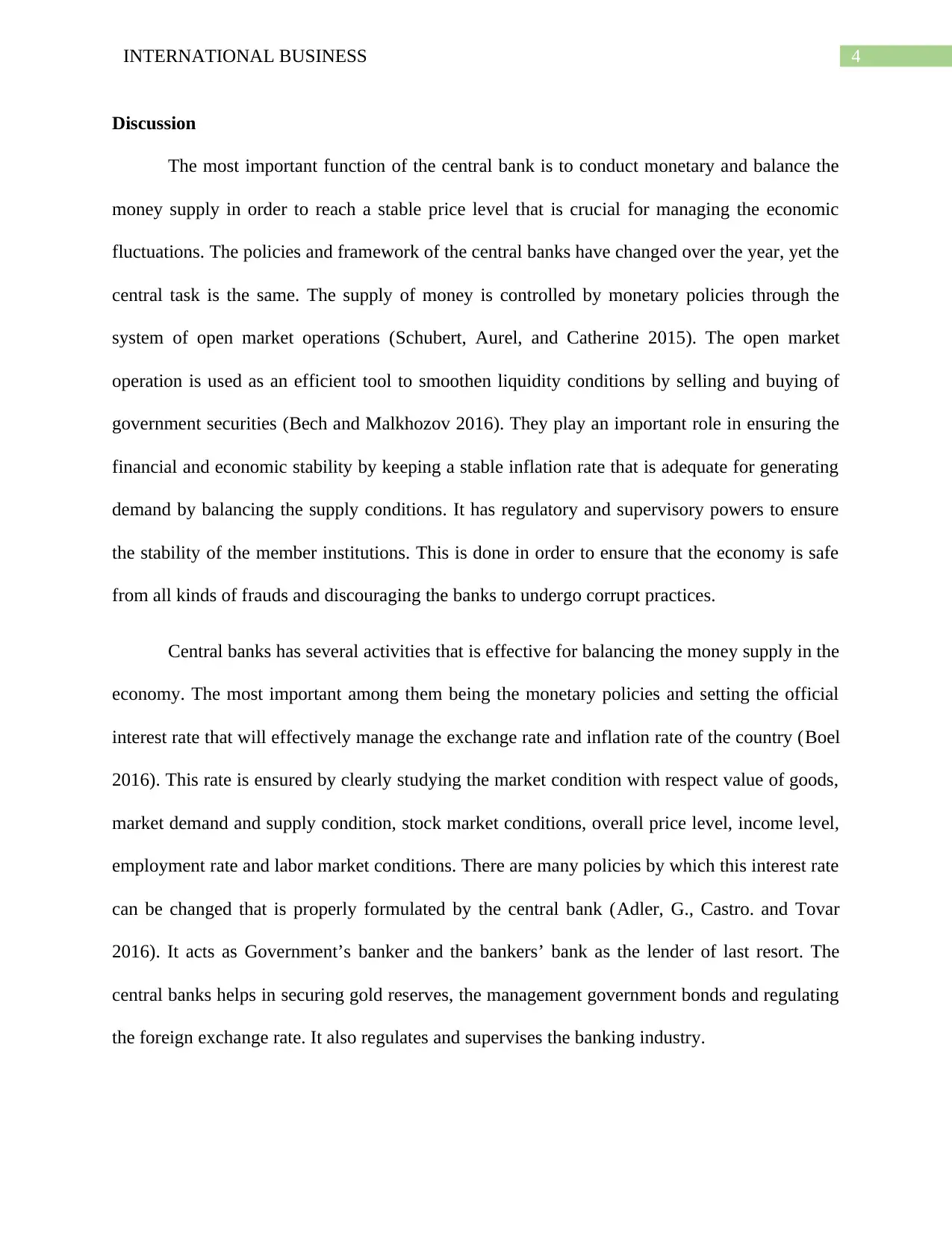
4INTERNATIONAL BUSINESS
Discussion
The most important function of the central bank is to conduct monetary and balance the
money supply in order to reach a stable price level that is crucial for managing the economic
fluctuations. The policies and framework of the central banks have changed over the year, yet the
central task is the same. The supply of money is controlled by monetary policies through the
system of open market operations (Schubert, Aurel, and Catherine 2015). The open market
operation is used as an efficient tool to smoothen liquidity conditions by selling and buying of
government securities (Bech and Malkhozov 2016). They play an important role in ensuring the
financial and economic stability by keeping a stable inflation rate that is adequate for generating
demand by balancing the supply conditions. It has regulatory and supervisory powers to ensure
the stability of the member institutions. This is done in order to ensure that the economy is safe
from all kinds of frauds and discouraging the banks to undergo corrupt practices.
Central banks has several activities that is effective for balancing the money supply in the
economy. The most important among them being the monetary policies and setting the official
interest rate that will effectively manage the exchange rate and inflation rate of the country (Boel
2016). This rate is ensured by clearly studying the market condition with respect value of goods,
market demand and supply condition, stock market conditions, overall price level, income level,
employment rate and labor market conditions. There are many policies by which this interest rate
can be changed that is properly formulated by the central bank (Adler, G., Castro. and Tovar
2016). It acts as Government’s banker and the bankers’ bank as the lender of last resort. The
central banks helps in securing gold reserves, the management government bonds and regulating
the foreign exchange rate. It also regulates and supervises the banking industry.
Discussion
The most important function of the central bank is to conduct monetary and balance the
money supply in order to reach a stable price level that is crucial for managing the economic
fluctuations. The policies and framework of the central banks have changed over the year, yet the
central task is the same. The supply of money is controlled by monetary policies through the
system of open market operations (Schubert, Aurel, and Catherine 2015). The open market
operation is used as an efficient tool to smoothen liquidity conditions by selling and buying of
government securities (Bech and Malkhozov 2016). They play an important role in ensuring the
financial and economic stability by keeping a stable inflation rate that is adequate for generating
demand by balancing the supply conditions. It has regulatory and supervisory powers to ensure
the stability of the member institutions. This is done in order to ensure that the economy is safe
from all kinds of frauds and discouraging the banks to undergo corrupt practices.
Central banks has several activities that is effective for balancing the money supply in the
economy. The most important among them being the monetary policies and setting the official
interest rate that will effectively manage the exchange rate and inflation rate of the country (Boel
2016). This rate is ensured by clearly studying the market condition with respect value of goods,
market demand and supply condition, stock market conditions, overall price level, income level,
employment rate and labor market conditions. There are many policies by which this interest rate
can be changed that is properly formulated by the central bank (Adler, G., Castro. and Tovar
2016). It acts as Government’s banker and the bankers’ bank as the lender of last resort. The
central banks helps in securing gold reserves, the management government bonds and regulating
the foreign exchange rate. It also regulates and supervises the banking industry.
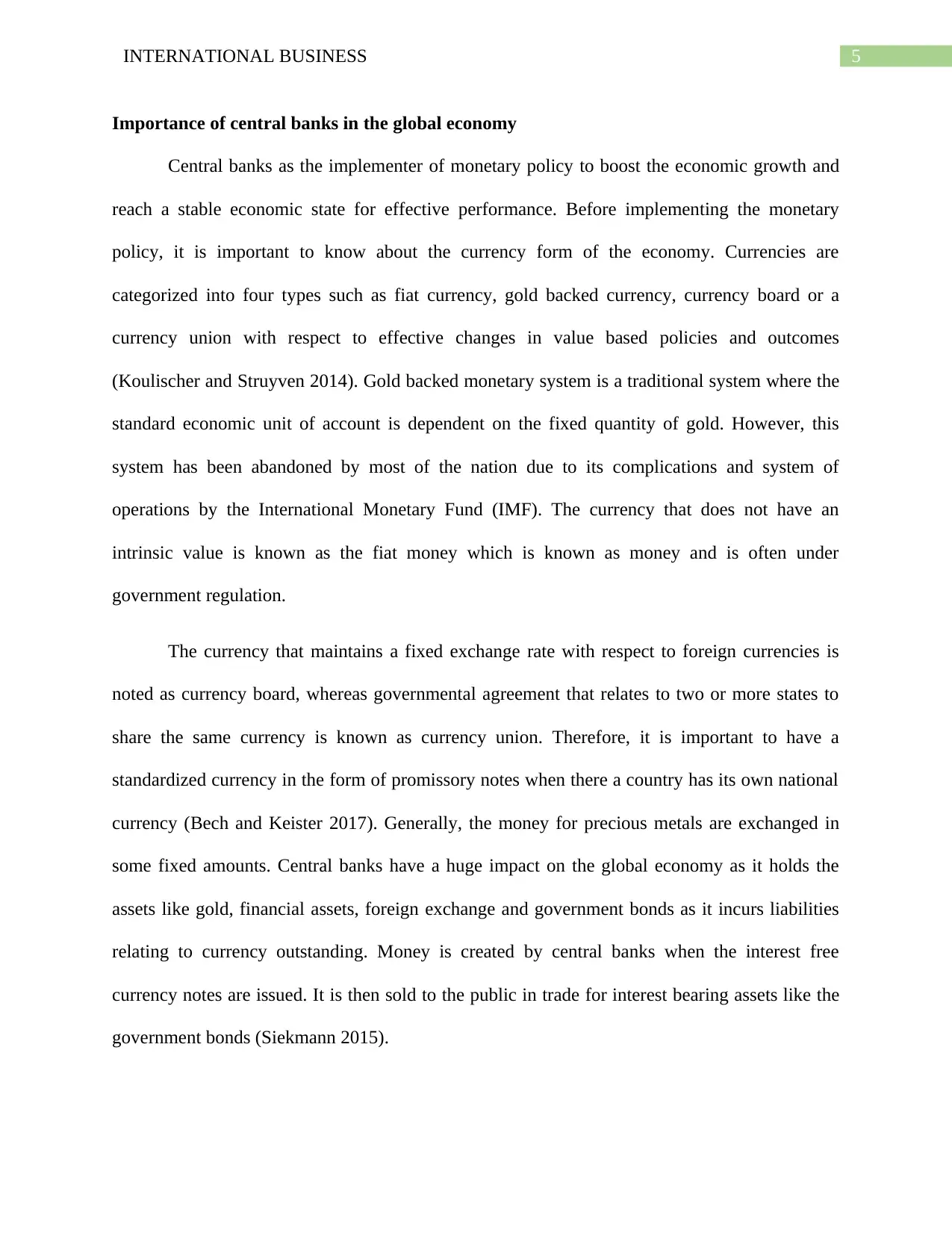
5INTERNATIONAL BUSINESS
Importance of central banks in the global economy
Central banks as the implementer of monetary policy to boost the economic growth and
reach a stable economic state for effective performance. Before implementing the monetary
policy, it is important to know about the currency form of the economy. Currencies are
categorized into four types such as fiat currency, gold backed currency, currency board or a
currency union with respect to effective changes in value based policies and outcomes
(Koulischer and Struyven 2014). Gold backed monetary system is a traditional system where the
standard economic unit of account is dependent on the fixed quantity of gold. However, this
system has been abandoned by most of the nation due to its complications and system of
operations by the International Monetary Fund (IMF). The currency that does not have an
intrinsic value is known as the fiat money which is known as money and is often under
government regulation.
The currency that maintains a fixed exchange rate with respect to foreign currencies is
noted as currency board, whereas governmental agreement that relates to two or more states to
share the same currency is known as currency union. Therefore, it is important to have a
standardized currency in the form of promissory notes when there a country has its own national
currency (Bech and Keister 2017). Generally, the money for precious metals are exchanged in
some fixed amounts. Central banks have a huge impact on the global economy as it holds the
assets like gold, financial assets, foreign exchange and government bonds as it incurs liabilities
relating to currency outstanding. Money is created by central banks when the interest free
currency notes are issued. It is then sold to the public in trade for interest bearing assets like the
government bonds (Siekmann 2015).
Importance of central banks in the global economy
Central banks as the implementer of monetary policy to boost the economic growth and
reach a stable economic state for effective performance. Before implementing the monetary
policy, it is important to know about the currency form of the economy. Currencies are
categorized into four types such as fiat currency, gold backed currency, currency board or a
currency union with respect to effective changes in value based policies and outcomes
(Koulischer and Struyven 2014). Gold backed monetary system is a traditional system where the
standard economic unit of account is dependent on the fixed quantity of gold. However, this
system has been abandoned by most of the nation due to its complications and system of
operations by the International Monetary Fund (IMF). The currency that does not have an
intrinsic value is known as the fiat money which is known as money and is often under
government regulation.
The currency that maintains a fixed exchange rate with respect to foreign currencies is
noted as currency board, whereas governmental agreement that relates to two or more states to
share the same currency is known as currency union. Therefore, it is important to have a
standardized currency in the form of promissory notes when there a country has its own national
currency (Bech and Keister 2017). Generally, the money for precious metals are exchanged in
some fixed amounts. Central banks have a huge impact on the global economy as it holds the
assets like gold, financial assets, foreign exchange and government bonds as it incurs liabilities
relating to currency outstanding. Money is created by central banks when the interest free
currency notes are issued. It is then sold to the public in trade for interest bearing assets like the
government bonds (Siekmann 2015).
⊘ This is a preview!⊘
Do you want full access?
Subscribe today to unlock all pages.

Trusted by 1+ million students worldwide
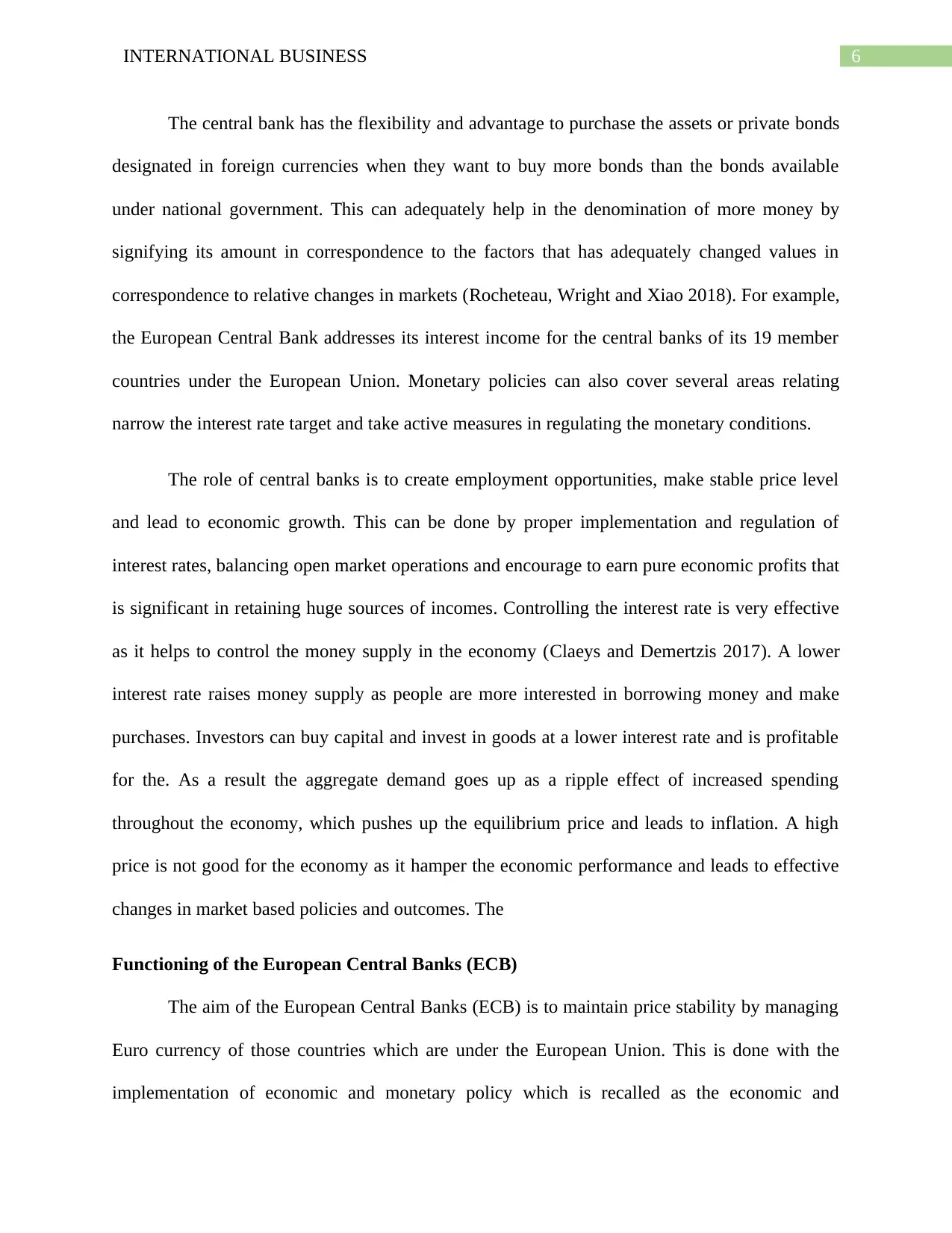
6INTERNATIONAL BUSINESS
The central bank has the flexibility and advantage to purchase the assets or private bonds
designated in foreign currencies when they want to buy more bonds than the bonds available
under national government. This can adequately help in the denomination of more money by
signifying its amount in correspondence to the factors that has adequately changed values in
correspondence to relative changes in markets (Rocheteau, Wright and Xiao 2018). For example,
the European Central Bank addresses its interest income for the central banks of its 19 member
countries under the European Union. Monetary policies can also cover several areas relating
narrow the interest rate target and take active measures in regulating the monetary conditions.
The role of central banks is to create employment opportunities, make stable price level
and lead to economic growth. This can be done by proper implementation and regulation of
interest rates, balancing open market operations and encourage to earn pure economic profits that
is significant in retaining huge sources of incomes. Controlling the interest rate is very effective
as it helps to control the money supply in the economy (Claeys and Demertzis 2017). A lower
interest rate raises money supply as people are more interested in borrowing money and make
purchases. Investors can buy capital and invest in goods at a lower interest rate and is profitable
for the. As a result the aggregate demand goes up as a ripple effect of increased spending
throughout the economy, which pushes up the equilibrium price and leads to inflation. A high
price is not good for the economy as it hamper the economic performance and leads to effective
changes in market based policies and outcomes. The
Functioning of the European Central Banks (ECB)
The aim of the European Central Banks (ECB) is to maintain price stability by managing
Euro currency of those countries which are under the European Union. This is done with the
implementation of economic and monetary policy which is recalled as the economic and
The central bank has the flexibility and advantage to purchase the assets or private bonds
designated in foreign currencies when they want to buy more bonds than the bonds available
under national government. This can adequately help in the denomination of more money by
signifying its amount in correspondence to the factors that has adequately changed values in
correspondence to relative changes in markets (Rocheteau, Wright and Xiao 2018). For example,
the European Central Bank addresses its interest income for the central banks of its 19 member
countries under the European Union. Monetary policies can also cover several areas relating
narrow the interest rate target and take active measures in regulating the monetary conditions.
The role of central banks is to create employment opportunities, make stable price level
and lead to economic growth. This can be done by proper implementation and regulation of
interest rates, balancing open market operations and encourage to earn pure economic profits that
is significant in retaining huge sources of incomes. Controlling the interest rate is very effective
as it helps to control the money supply in the economy (Claeys and Demertzis 2017). A lower
interest rate raises money supply as people are more interested in borrowing money and make
purchases. Investors can buy capital and invest in goods at a lower interest rate and is profitable
for the. As a result the aggregate demand goes up as a ripple effect of increased spending
throughout the economy, which pushes up the equilibrium price and leads to inflation. A high
price is not good for the economy as it hamper the economic performance and leads to effective
changes in market based policies and outcomes. The
Functioning of the European Central Banks (ECB)
The aim of the European Central Banks (ECB) is to maintain price stability by managing
Euro currency of those countries which are under the European Union. This is done with the
implementation of economic and monetary policy which is recalled as the economic and
Paraphrase This Document
Need a fresh take? Get an instant paraphrase of this document with our AI Paraphraser
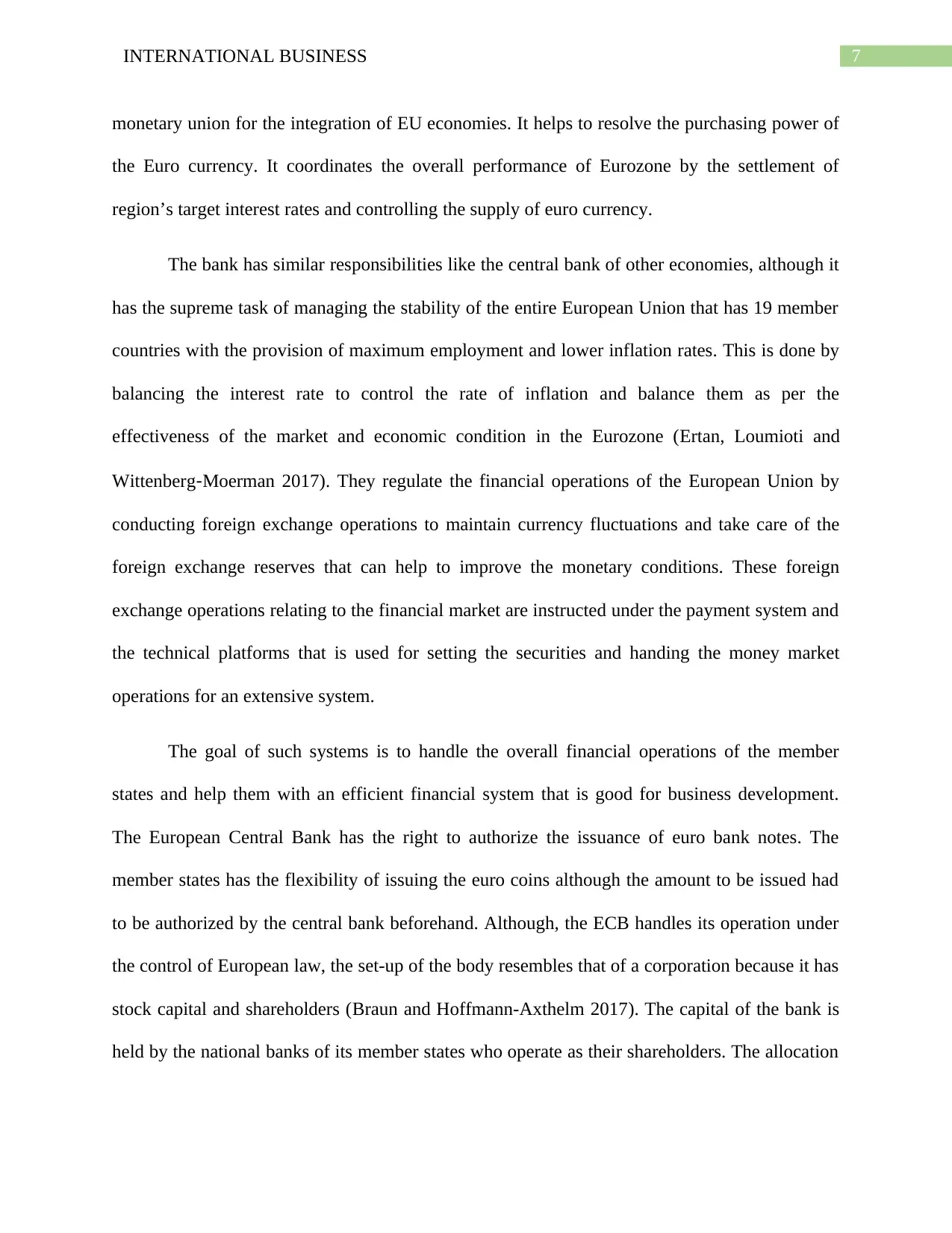
7INTERNATIONAL BUSINESS
monetary union for the integration of EU economies. It helps to resolve the purchasing power of
the Euro currency. It coordinates the overall performance of Eurozone by the settlement of
region’s target interest rates and controlling the supply of euro currency.
The bank has similar responsibilities like the central bank of other economies, although it
has the supreme task of managing the stability of the entire European Union that has 19 member
countries with the provision of maximum employment and lower inflation rates. This is done by
balancing the interest rate to control the rate of inflation and balance them as per the
effectiveness of the market and economic condition in the Eurozone (Ertan, Loumioti and
Wittenberg‐Moerman 2017). They regulate the financial operations of the European Union by
conducting foreign exchange operations to maintain currency fluctuations and take care of the
foreign exchange reserves that can help to improve the monetary conditions. These foreign
exchange operations relating to the financial market are instructed under the payment system and
the technical platforms that is used for setting the securities and handing the money market
operations for an extensive system.
The goal of such systems is to handle the overall financial operations of the member
states and help them with an efficient financial system that is good for business development.
The European Central Bank has the right to authorize the issuance of euro bank notes. The
member states has the flexibility of issuing the euro coins although the amount to be issued had
to be authorized by the central bank beforehand. Although, the ECB handles its operation under
the control of European law, the set-up of the body resembles that of a corporation because it has
stock capital and shareholders (Braun and Hoffmann-Axthelm 2017). The capital of the bank is
held by the national banks of its member states who operate as their shareholders. The allocation
monetary union for the integration of EU economies. It helps to resolve the purchasing power of
the Euro currency. It coordinates the overall performance of Eurozone by the settlement of
region’s target interest rates and controlling the supply of euro currency.
The bank has similar responsibilities like the central bank of other economies, although it
has the supreme task of managing the stability of the entire European Union that has 19 member
countries with the provision of maximum employment and lower inflation rates. This is done by
balancing the interest rate to control the rate of inflation and balance them as per the
effectiveness of the market and economic condition in the Eurozone (Ertan, Loumioti and
Wittenberg‐Moerman 2017). They regulate the financial operations of the European Union by
conducting foreign exchange operations to maintain currency fluctuations and take care of the
foreign exchange reserves that can help to improve the monetary conditions. These foreign
exchange operations relating to the financial market are instructed under the payment system and
the technical platforms that is used for setting the securities and handing the money market
operations for an extensive system.
The goal of such systems is to handle the overall financial operations of the member
states and help them with an efficient financial system that is good for business development.
The European Central Bank has the right to authorize the issuance of euro bank notes. The
member states has the flexibility of issuing the euro coins although the amount to be issued had
to be authorized by the central bank beforehand. Although, the ECB handles its operation under
the control of European law, the set-up of the body resembles that of a corporation because it has
stock capital and shareholders (Braun and Hoffmann-Axthelm 2017). The capital of the bank is
held by the national banks of its member states who operate as their shareholders. The allocation
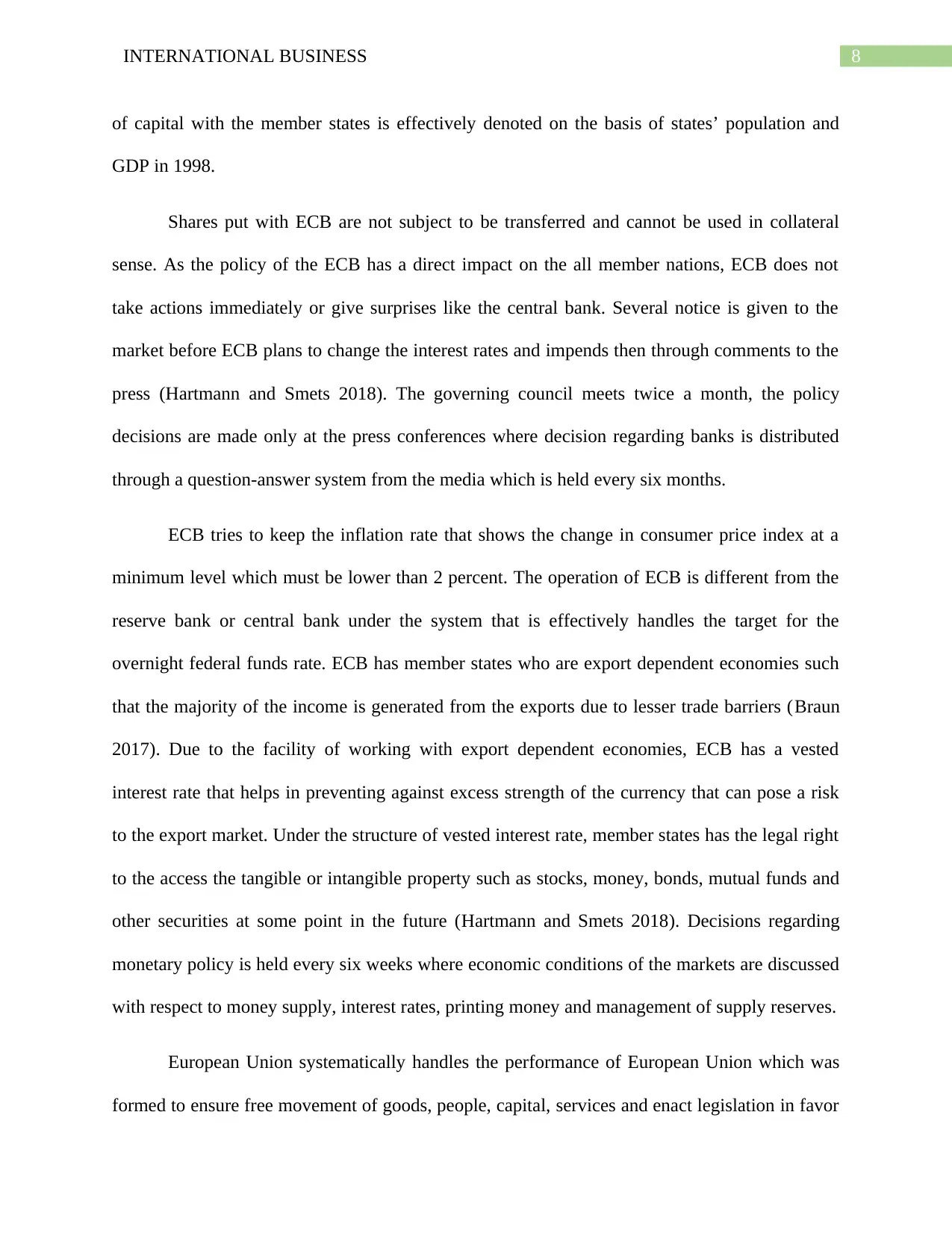
8INTERNATIONAL BUSINESS
of capital with the member states is effectively denoted on the basis of states’ population and
GDP in 1998.
Shares put with ECB are not subject to be transferred and cannot be used in collateral
sense. As the policy of the ECB has a direct impact on the all member nations, ECB does not
take actions immediately or give surprises like the central bank. Several notice is given to the
market before ECB plans to change the interest rates and impends then through comments to the
press (Hartmann and Smets 2018). The governing council meets twice a month, the policy
decisions are made only at the press conferences where decision regarding banks is distributed
through a question-answer system from the media which is held every six months.
ECB tries to keep the inflation rate that shows the change in consumer price index at a
minimum level which must be lower than 2 percent. The operation of ECB is different from the
reserve bank or central bank under the system that is effectively handles the target for the
overnight federal funds rate. ECB has member states who are export dependent economies such
that the majority of the income is generated from the exports due to lesser trade barriers (Braun
2017). Due to the facility of working with export dependent economies, ECB has a vested
interest rate that helps in preventing against excess strength of the currency that can pose a risk
to the export market. Under the structure of vested interest rate, member states has the legal right
to the access the tangible or intangible property such as stocks, money, bonds, mutual funds and
other securities at some point in the future (Hartmann and Smets 2018). Decisions regarding
monetary policy is held every six weeks where economic conditions of the markets are discussed
with respect to money supply, interest rates, printing money and management of supply reserves.
European Union systematically handles the performance of European Union which was
formed to ensure free movement of goods, people, capital, services and enact legislation in favor
of capital with the member states is effectively denoted on the basis of states’ population and
GDP in 1998.
Shares put with ECB are not subject to be transferred and cannot be used in collateral
sense. As the policy of the ECB has a direct impact on the all member nations, ECB does not
take actions immediately or give surprises like the central bank. Several notice is given to the
market before ECB plans to change the interest rates and impends then through comments to the
press (Hartmann and Smets 2018). The governing council meets twice a month, the policy
decisions are made only at the press conferences where decision regarding banks is distributed
through a question-answer system from the media which is held every six months.
ECB tries to keep the inflation rate that shows the change in consumer price index at a
minimum level which must be lower than 2 percent. The operation of ECB is different from the
reserve bank or central bank under the system that is effectively handles the target for the
overnight federal funds rate. ECB has member states who are export dependent economies such
that the majority of the income is generated from the exports due to lesser trade barriers (Braun
2017). Due to the facility of working with export dependent economies, ECB has a vested
interest rate that helps in preventing against excess strength of the currency that can pose a risk
to the export market. Under the structure of vested interest rate, member states has the legal right
to the access the tangible or intangible property such as stocks, money, bonds, mutual funds and
other securities at some point in the future (Hartmann and Smets 2018). Decisions regarding
monetary policy is held every six weeks where economic conditions of the markets are discussed
with respect to money supply, interest rates, printing money and management of supply reserves.
European Union systematically handles the performance of European Union which was
formed to ensure free movement of goods, people, capital, services and enact legislation in favor
⊘ This is a preview!⊘
Do you want full access?
Subscribe today to unlock all pages.

Trusted by 1+ million students worldwide
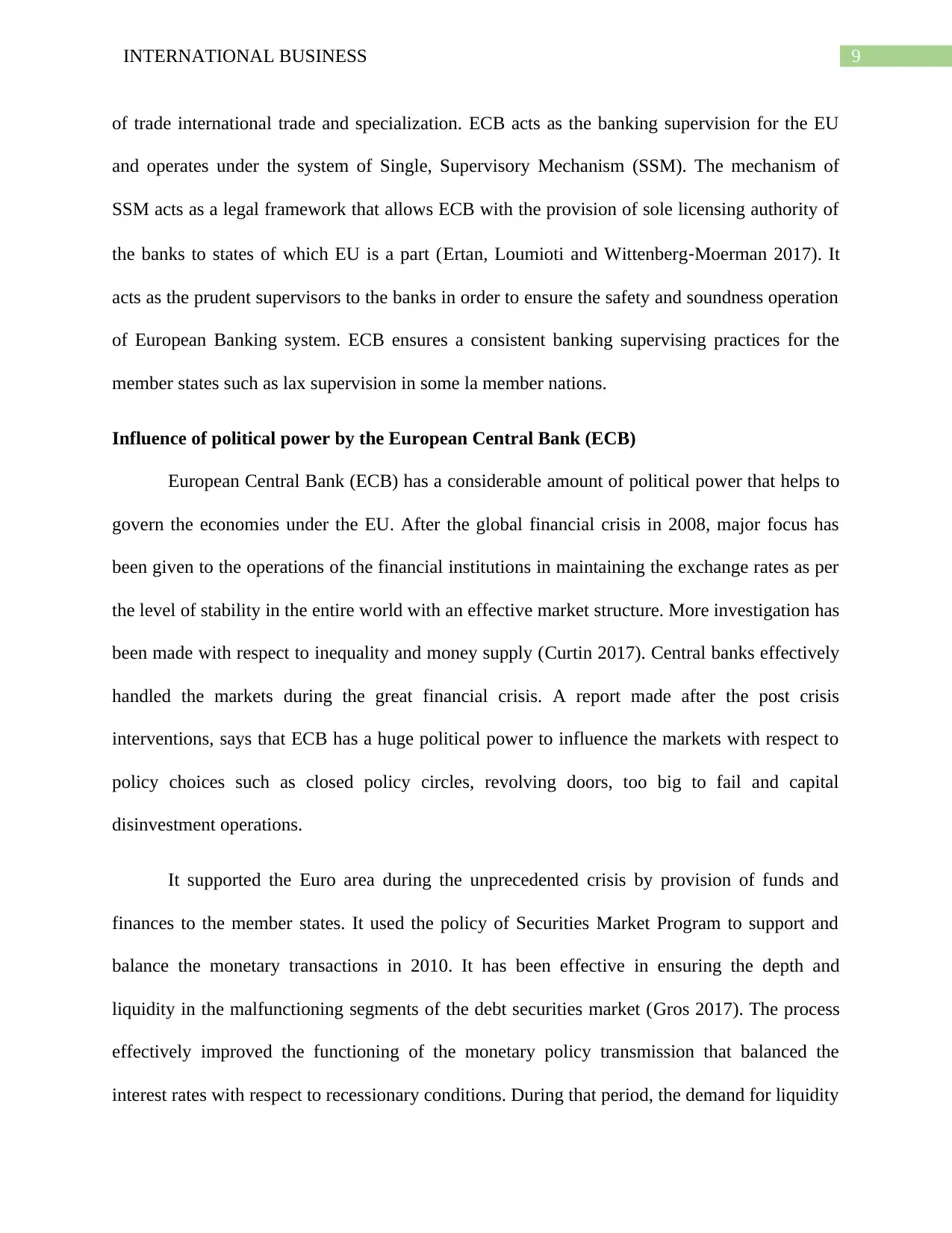
9INTERNATIONAL BUSINESS
of trade international trade and specialization. ECB acts as the banking supervision for the EU
and operates under the system of Single, Supervisory Mechanism (SSM). The mechanism of
SSM acts as a legal framework that allows ECB with the provision of sole licensing authority of
the banks to states of which EU is a part (Ertan, Loumioti and Wittenberg‐Moerman 2017). It
acts as the prudent supervisors to the banks in order to ensure the safety and soundness operation
of European Banking system. ECB ensures a consistent banking supervising practices for the
member states such as lax supervision in some la member nations.
Influence of political power by the European Central Bank (ECB)
European Central Bank (ECB) has a considerable amount of political power that helps to
govern the economies under the EU. After the global financial crisis in 2008, major focus has
been given to the operations of the financial institutions in maintaining the exchange rates as per
the level of stability in the entire world with an effective market structure. More investigation has
been made with respect to inequality and money supply (Curtin 2017). Central banks effectively
handled the markets during the great financial crisis. A report made after the post crisis
interventions, says that ECB has a huge political power to influence the markets with respect to
policy choices such as closed policy circles, revolving doors, too big to fail and capital
disinvestment operations.
It supported the Euro area during the unprecedented crisis by provision of funds and
finances to the member states. It used the policy of Securities Market Program to support and
balance the monetary transactions in 2010. It has been effective in ensuring the depth and
liquidity in the malfunctioning segments of the debt securities market (Gros 2017). The process
effectively improved the functioning of the monetary policy transmission that balanced the
interest rates with respect to recessionary conditions. During that period, the demand for liquidity
of trade international trade and specialization. ECB acts as the banking supervision for the EU
and operates under the system of Single, Supervisory Mechanism (SSM). The mechanism of
SSM acts as a legal framework that allows ECB with the provision of sole licensing authority of
the banks to states of which EU is a part (Ertan, Loumioti and Wittenberg‐Moerman 2017). It
acts as the prudent supervisors to the banks in order to ensure the safety and soundness operation
of European Banking system. ECB ensures a consistent banking supervising practices for the
member states such as lax supervision in some la member nations.
Influence of political power by the European Central Bank (ECB)
European Central Bank (ECB) has a considerable amount of political power that helps to
govern the economies under the EU. After the global financial crisis in 2008, major focus has
been given to the operations of the financial institutions in maintaining the exchange rates as per
the level of stability in the entire world with an effective market structure. More investigation has
been made with respect to inequality and money supply (Curtin 2017). Central banks effectively
handled the markets during the great financial crisis. A report made after the post crisis
interventions, says that ECB has a huge political power to influence the markets with respect to
policy choices such as closed policy circles, revolving doors, too big to fail and capital
disinvestment operations.
It supported the Euro area during the unprecedented crisis by provision of funds and
finances to the member states. It used the policy of Securities Market Program to support and
balance the monetary transactions in 2010. It has been effective in ensuring the depth and
liquidity in the malfunctioning segments of the debt securities market (Gros 2017). The process
effectively improved the functioning of the monetary policy transmission that balanced the
interest rates with respect to recessionary conditions. During that period, the demand for liquidity
Paraphrase This Document
Need a fresh take? Get an instant paraphrase of this document with our AI Paraphraser
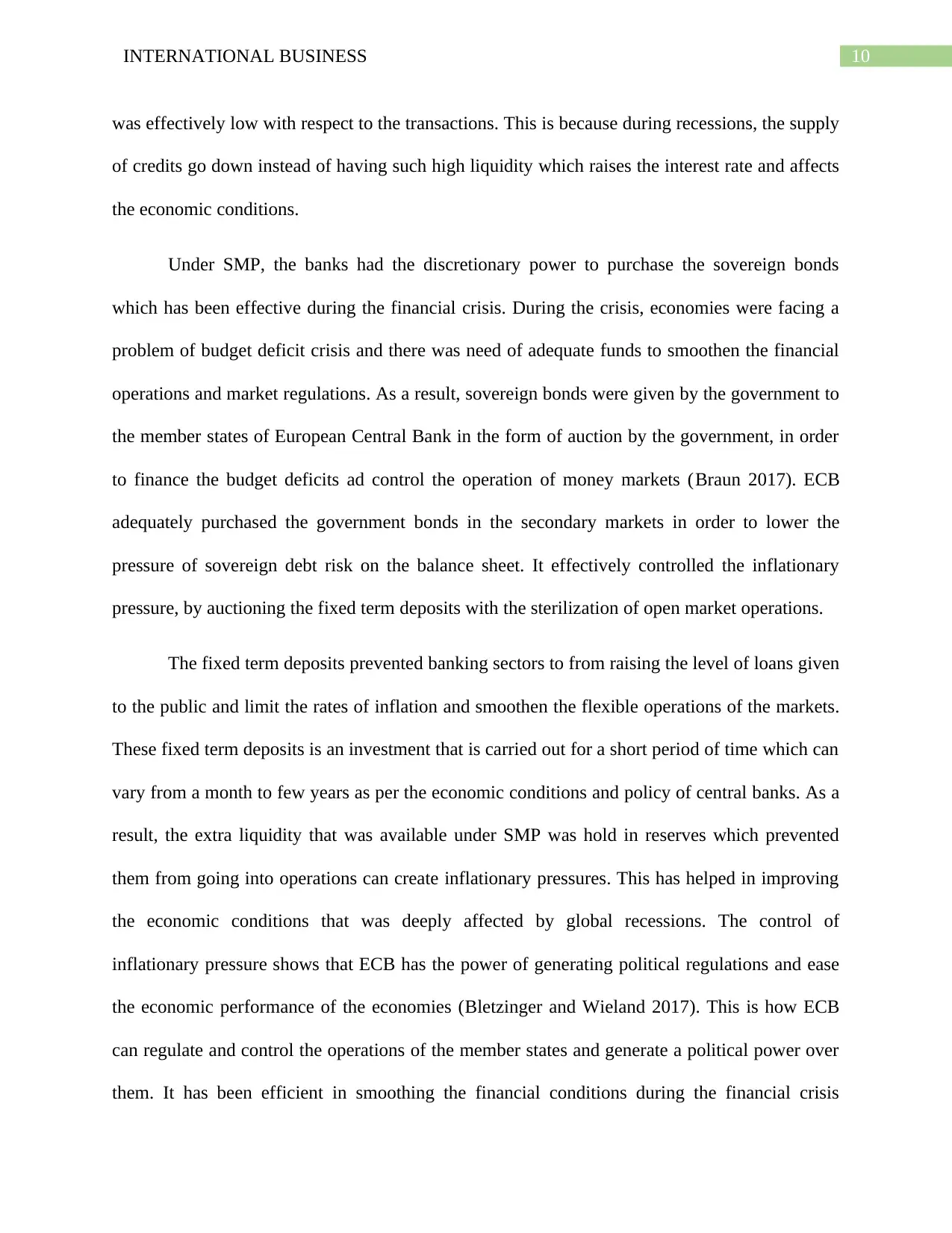
10INTERNATIONAL BUSINESS
was effectively low with respect to the transactions. This is because during recessions, the supply
of credits go down instead of having such high liquidity which raises the interest rate and affects
the economic conditions.
Under SMP, the banks had the discretionary power to purchase the sovereign bonds
which has been effective during the financial crisis. During the crisis, economies were facing a
problem of budget deficit crisis and there was need of adequate funds to smoothen the financial
operations and market regulations. As a result, sovereign bonds were given by the government to
the member states of European Central Bank in the form of auction by the government, in order
to finance the budget deficits ad control the operation of money markets (Braun 2017). ECB
adequately purchased the government bonds in the secondary markets in order to lower the
pressure of sovereign debt risk on the balance sheet. It effectively controlled the inflationary
pressure, by auctioning the fixed term deposits with the sterilization of open market operations.
The fixed term deposits prevented banking sectors to from raising the level of loans given
to the public and limit the rates of inflation and smoothen the flexible operations of the markets.
These fixed term deposits is an investment that is carried out for a short period of time which can
vary from a month to few years as per the economic conditions and policy of central banks. As a
result, the extra liquidity that was available under SMP was hold in reserves which prevented
them from going into operations can create inflationary pressures. This has helped in improving
the economic conditions that was deeply affected by global recessions. The control of
inflationary pressure shows that ECB has the power of generating political regulations and ease
the economic performance of the economies (Bletzinger and Wieland 2017). This is how ECB
can regulate and control the operations of the member states and generate a political power over
them. It has been efficient in smoothing the financial conditions during the financial crisis
was effectively low with respect to the transactions. This is because during recessions, the supply
of credits go down instead of having such high liquidity which raises the interest rate and affects
the economic conditions.
Under SMP, the banks had the discretionary power to purchase the sovereign bonds
which has been effective during the financial crisis. During the crisis, economies were facing a
problem of budget deficit crisis and there was need of adequate funds to smoothen the financial
operations and market regulations. As a result, sovereign bonds were given by the government to
the member states of European Central Bank in the form of auction by the government, in order
to finance the budget deficits ad control the operation of money markets (Braun 2017). ECB
adequately purchased the government bonds in the secondary markets in order to lower the
pressure of sovereign debt risk on the balance sheet. It effectively controlled the inflationary
pressure, by auctioning the fixed term deposits with the sterilization of open market operations.
The fixed term deposits prevented banking sectors to from raising the level of loans given
to the public and limit the rates of inflation and smoothen the flexible operations of the markets.
These fixed term deposits is an investment that is carried out for a short period of time which can
vary from a month to few years as per the economic conditions and policy of central banks. As a
result, the extra liquidity that was available under SMP was hold in reserves which prevented
them from going into operations can create inflationary pressures. This has helped in improving
the economic conditions that was deeply affected by global recessions. The control of
inflationary pressure shows that ECB has the power of generating political regulations and ease
the economic performance of the economies (Bletzinger and Wieland 2017). This is how ECB
can regulate and control the operations of the member states and generate a political power over
them. It has been efficient in smoothing the financial conditions during the financial crisis
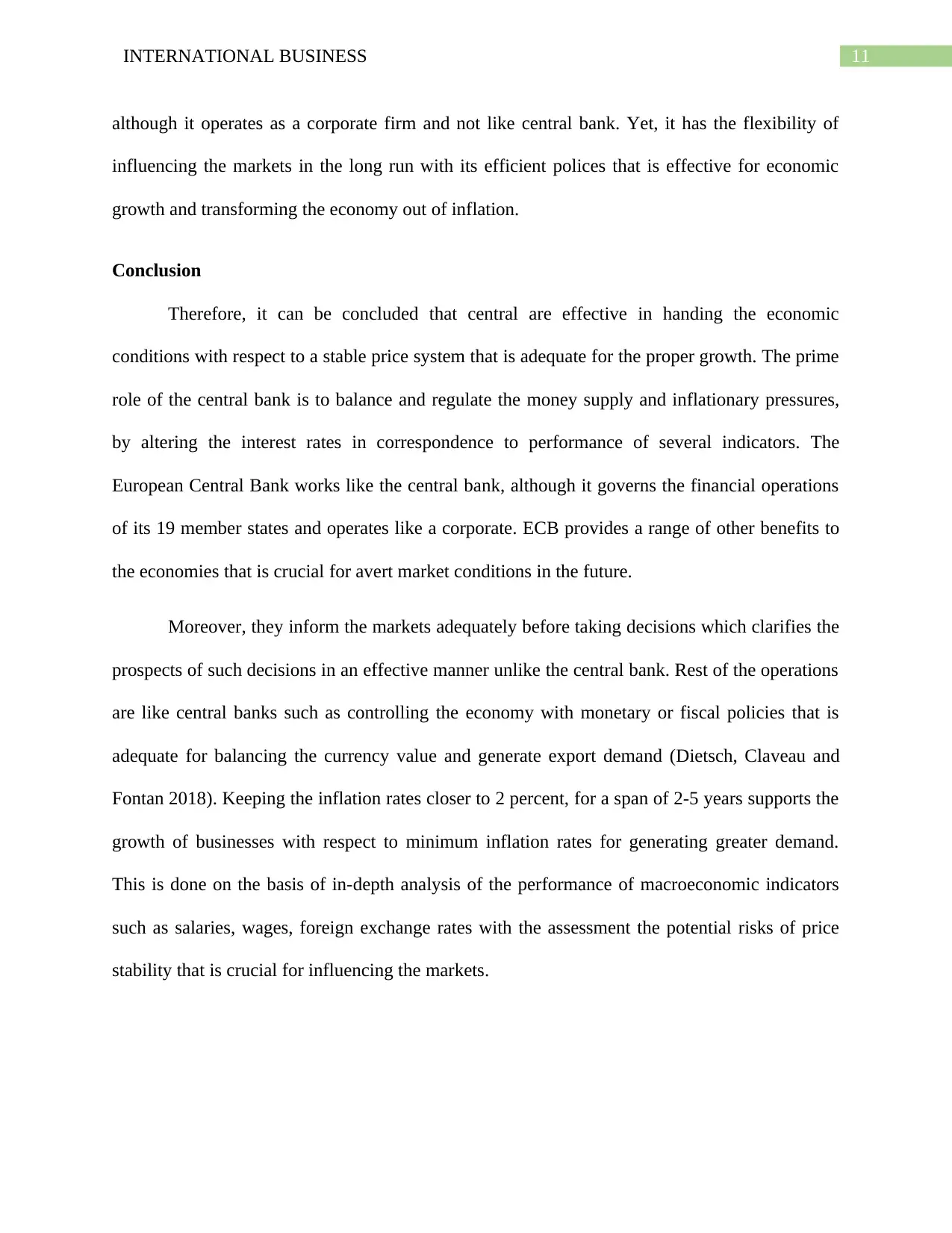
11INTERNATIONAL BUSINESS
although it operates as a corporate firm and not like central bank. Yet, it has the flexibility of
influencing the markets in the long run with its efficient polices that is effective for economic
growth and transforming the economy out of inflation.
Conclusion
Therefore, it can be concluded that central are effective in handing the economic
conditions with respect to a stable price system that is adequate for the proper growth. The prime
role of the central bank is to balance and regulate the money supply and inflationary pressures,
by altering the interest rates in correspondence to performance of several indicators. The
European Central Bank works like the central bank, although it governs the financial operations
of its 19 member states and operates like a corporate. ECB provides a range of other benefits to
the economies that is crucial for avert market conditions in the future.
Moreover, they inform the markets adequately before taking decisions which clarifies the
prospects of such decisions in an effective manner unlike the central bank. Rest of the operations
are like central banks such as controlling the economy with monetary or fiscal policies that is
adequate for balancing the currency value and generate export demand (Dietsch, Claveau and
Fontan 2018). Keeping the inflation rates closer to 2 percent, for a span of 2-5 years supports the
growth of businesses with respect to minimum inflation rates for generating greater demand.
This is done on the basis of in-depth analysis of the performance of macroeconomic indicators
such as salaries, wages, foreign exchange rates with the assessment the potential risks of price
stability that is crucial for influencing the markets.
although it operates as a corporate firm and not like central bank. Yet, it has the flexibility of
influencing the markets in the long run with its efficient polices that is effective for economic
growth and transforming the economy out of inflation.
Conclusion
Therefore, it can be concluded that central are effective in handing the economic
conditions with respect to a stable price system that is adequate for the proper growth. The prime
role of the central bank is to balance and regulate the money supply and inflationary pressures,
by altering the interest rates in correspondence to performance of several indicators. The
European Central Bank works like the central bank, although it governs the financial operations
of its 19 member states and operates like a corporate. ECB provides a range of other benefits to
the economies that is crucial for avert market conditions in the future.
Moreover, they inform the markets adequately before taking decisions which clarifies the
prospects of such decisions in an effective manner unlike the central bank. Rest of the operations
are like central banks such as controlling the economy with monetary or fiscal policies that is
adequate for balancing the currency value and generate export demand (Dietsch, Claveau and
Fontan 2018). Keeping the inflation rates closer to 2 percent, for a span of 2-5 years supports the
growth of businesses with respect to minimum inflation rates for generating greater demand.
This is done on the basis of in-depth analysis of the performance of macroeconomic indicators
such as salaries, wages, foreign exchange rates with the assessment the potential risks of price
stability that is crucial for influencing the markets.
⊘ This is a preview!⊘
Do you want full access?
Subscribe today to unlock all pages.

Trusted by 1+ million students worldwide
1 out of 15
Related Documents
Your All-in-One AI-Powered Toolkit for Academic Success.
+13062052269
info@desklib.com
Available 24*7 on WhatsApp / Email
![[object Object]](/_next/static/media/star-bottom.7253800d.svg)
Unlock your academic potential
Copyright © 2020–2025 A2Z Services. All Rights Reserved. Developed and managed by ZUCOL.





